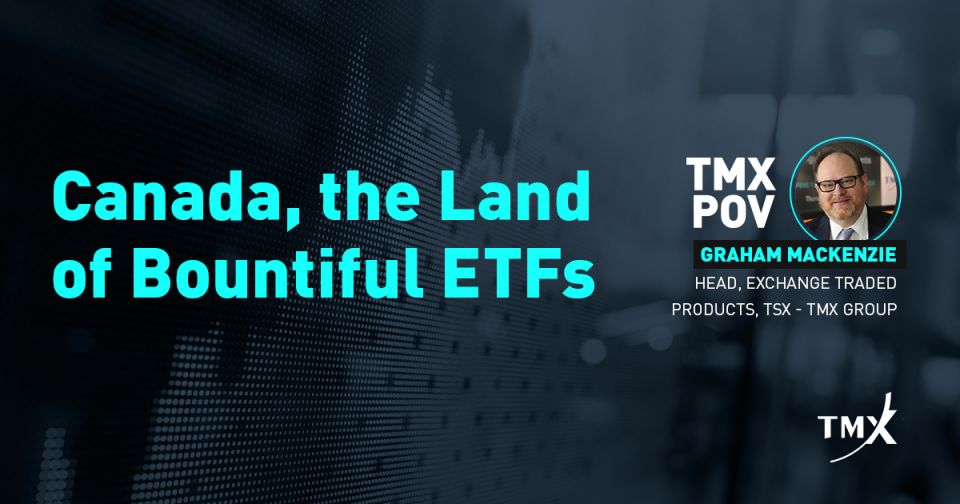TMX POV - Canada, the Land of Bountiful ETFs

It was a virtual work call and if it was pre-COVID 19. I'm sure everyone would have seen my eyes roll. My annoyance and somewhat frustration was directed at a colleague who just suggested that it would be timely to buy SPY (the NYSE Arca listed and world's largest ETF tracking the S&P 500) to capitalize on recent US specific news. To be fair, my colleague is not engaged in our ETF business and is also a little removed from day to day markets. His comments though resonated with me. Far too many Canadians have yet to grasp how diverse and broad the Canadian ETF shelf has grown.
I wanted to interrupt my colleague and suggested he meant to say ZSP or XSP instead of SPY but I knew that response would be met with bewilderment. ZSP (BMO S&P 500 Index ETF) and XSP (iShares Core S&P 500 Index ETF) represent two of the largest ETFs listed in Canada and also track the same bellwether S&P 500 index that SPY does. There certainly was a time when Canadians had to head south to the US markets but that was honestly a long time ago.
For a Canadian looking for exposure to the S&P 500, there are actually a whole slew of products available to them. Currently, there are 19 ETFs listed on Toronto Stock Exchange (TSX) and more than $35 billion that track the S&P 500 in some manner or another. That number grows to 23 when you include the leveraged and inverse funds indexed to the S&P 500. On the surface, that might sound excessive but as you dig deeper at this list, you start to see how each of the products differentiate and offer optionality to investors. The options vary from Canadian dollar to currency hedged to ESG to inverse and leveraged versions based on the S&P 500 Index.
| Symbol | Fund Name | MER [%] | AUM [$] |
|---|---|---|---|
| ZSP | BMO S&P 500 Index ETF CAD units | 0.08 | 9.99 B |
| XSP | iShares Core S&P 500 Index ETF (CAD-Hedged) units | 0.1 | 6.83 B |
| VFV | Vanguard S&P 500 Index ETF redeemable transferable units | 0.08 | 4.05 B |
| XUS | iShares Core S&P 500 Index ETF Units | 0.1 | 3.26 B |
| ZUE | BMO S&P 500 Hedged to CAD Index ETF CAD units | 0.08 | 2.38 B |
| HXS | Horizons S&P 500 Index ETF ETF Shares | 0.1 | 2.21 B |
| ZSP.U | BMO S&P 500 Index ETF USD units | 0.08 | 1.75 B |
| HXS.U | Horizons S&P 500 Index ETF ETF Shares | 0.1 | 1.74 B |
| VSP | Vanguard S&P 500 Index ETF (CAD-hedged) redeemable transferable units | 0.08 | 1.53 B |
| ULV.F | Invesco S&P 500 Low Volatility Index ETF redeemable transferable units | 0.3 | 216.08 M |
| HSH | Horizons S&P 500 CAD Hedged Index ETF ETF Shares | 0.1 | 196.24 M |
| EQL.F | Invesco S&P 500 Equal Weight Index ETF CAD Hedged Units | 0.26 | 148.09 M |
| EQL | Invesco S&P 500 Equal Weight Index ETF CAD Units | 0.26 | 113.88 M |
| ULV.C | Invesco S&P 500 Low Volatility Index ETF CAD Units | 0.31 | 42.05 M |
| ESG | Invesco S&P 500 ESG Index ETF CAD Units | 0.15 | 29.18 M |
| XUS.U | iShares Core S&P 500 Index ETF USD Units | 0.1 | 25.93 M |
| ESG.F | Invesco S&P 500 ESG Index ETF CAD Hedged Units | 0.15 | 7.85 M |
| ULV.U | Invesco S&P 500 Low Volatility Index ETF USD Units | 0.31 | 5.7 M |
| EQL.U | Invesco S&P 500 Equal Weight Index ETF USD Units | 0.26 | 4.19 M |
Source: Quotemedia as of February 17, 2021
For many generations of Canadians, we believed what lies south of the border is always better and cheaper. For ETFs, like many consumer products, a lot has changed. If we narrow in on those 19 ETFs that track the S&P 500, in some fashion or another, it's worth noting that five of them have a management expense ratio (MER) of 0.08% vs. SPY's 0.09%. The majority of these TSX-listed S&P 500 ETFs come in with a MER of 0.10% or less. More than half of the dollars tracking TSX-listed S&P 500 ETFs are paying less than its US heavyweight peer. Many of those with higher MERs have added features that increase to their costs.
While no one has yet to list an ETF like AdvisorShares Vice ETF (US: VICE) that seeks long-term growth from companies operating in "vice" industries (alcohol, tobacco, gaming and etc) or the once US listed obesity ETF (SLIM) in Canada, there are still lots of ETFs that give Canadians access to both emerging themes and sectors. At the end of 2020, according to the Canadian ETF Association (CETFA) there were 117 thematic and sectoral ETFs listed in Canada. These types of ETFs give Canadians a much needed vehicle for them to execute their tactical and diversification strategies that compliment their core investment portfolio.
Opportunities for portfolio growth and income are obviously not limited to just north of the 49th parallel. Canadian investors have always searched out the world for what fits their investment needs, some 695 of the 984 ETFs traded on TSX offer some regional exposure beyond our border. Whether Canadians wish to capitalize on the growth opportunities in emerging markets or higher yielding bank stocks in Australia you do not need to go south of the border or across any oceans to achieve those needs.
One of the most significant benefits of Canadian listed ETFs that track foreign or US securities is the foreign exchange rates inherent in the Canadian dollar listings. It's no secret that Canadian retail investors pay steep rates for foreign exchange when making investments abroad. The nature in which ETF liquidity is delivered by market makers means no matter if you are a retail investor or an institutional investor you are getting competitive foreign exchange rates. When you head south to buy and sell ETFs listed in the US, the investor themselves must manage their own currency exchange for which they're at the mercy of their provider, instead of a market making desk that has access to institutional exchange rates.
One of the greatest misconceptions with ETFs is that liquidity is derived from supply and demand like stocks. While stock prices head higher as sellers disappear, liquidity for ETFs is not based on the same notion or mechanics. It's the supply and demand for the underlying portfolio that sets the liquidity of the ETF. As demand for any ETF increases a market maker can facilitate that demand by creating new units to sell by buying the underlying portfolio. This means that a similar ETF in the US that might have multiples of assets under management and higher daily volumes is essentially just as liquid. The fabric that makes this all happen is our market makers. Canadians have been making markets in ETFs longer than anyone. If it wasn't for the sophistication and intuition of our Canadian market makers the world's first equity, fixed income and Bitcoin ETFs probably wouldn't have happened here.
Sometimes there is nothing more Canadian than to assume the grass is greener elsewhere. When it comes to access to a liquid and broad array of ETFs Canadians really don't need to look beyond the shelf right here at home.
Copyright © 2021 TSX Inc. All rights reserved. Do not copy, distribute, sell or modify this document without TSX Inc.'s prior written consent. This information is provided for information purposes only. Neither TMX Group Limited nor any of its affiliated companies guarantees the completeness of the information contained in this publication, and we are not responsible for any errors or omissions in or your use of, or reliance on, the information. This article is not intended to provide legal, accounting, tax, investment, financial or other advice and should not be relied upon for such advice. The information provided is not an invitation to purchase securities listed on Toronto Stock Exchange and/or TSX Venture Exchange. TMX Group and its affiliated companies do not endorse or recommend any securities referenced in this publication. TMX, the TMX design, The Future is Yours to See., Toronto Stock Exchange, TSX, and Voir le futur. Réaliser l'avenir. are the trademarks of TSX Inc. All other trademarks used are the property of their respective owners.


